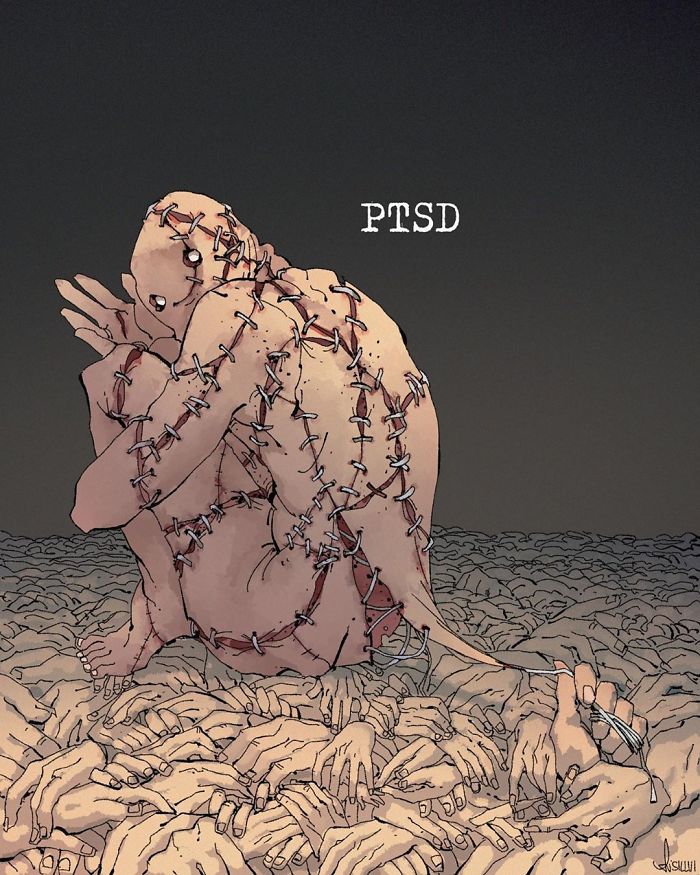Whether we're talking about Melancholia (1514) by Albrecht Durer or The Scream (1893) by Edvard Munch, artists have been portraying mental disorders for centuries. These difficult subjects are important to current online creators as well. Shawn Coss, for example, has tackled them numerous times in 2016 as well as 2018. Recently, Korean-born Canadian artist Sillvi also decided to explore these grim alleys.
More info: Instagram | Facebook
This post may include affiliate links.
"Depression is a mood disorder that causes a persistent feeling of sadness and loss of interest. Also called major depressive disorder or clinical depression, it affects how you feel, think and behave and can lead to a variety of emotional and physical problems. You may have trouble doing normal day-to-day activities, and sometimes you may feel as if life isn't worth living. -Mayo Clinic"
"I don't want to claim originality for this character design idea," Sillvi told Bored Panda. "I've seen multiple artists depict mental illnesses as monsters. What motivated me to do my own version was because these depictions seemed to either romanticize or demonize mental health disorders. Majority of them focused on manifesting some sort of creepy creature that causes pain to their victims. I didn't want to draw monsters. I wanted to draw how they feel, and that was the initial motivation."
"Alzheimer's disease is a progressive disorder that causes brain cells to waste away (degenerate) and die. Alzheimer's disease is the most common cause of dementia — a continuous decline in thinking, behavioral and social skills that disrupts a person's ability to function independently." -Mayo Clinic
Sillvi acknowledged that portraying these kinds of things can be very difficult. "My dark drawings are not perfect, and the experiences of those suffering from them can differ for each individual. I've made sure to include excerpts from credible sources on each mental health illness I covered in the description of my Instagram posts. The last thing I want is spreading misinformation."
"Quite often, the term “anxiety attack” and “panic attack” are used interchangeably, but they are not the same condition.
Anxiety disorders include disorders that share features of excessive fear and anxiety and related behavioral disturbances. Fear is the emotional response to real or perceived imminent threat, whereas anxiety is anticipation of future threat. Obviously, these two states overlap, but they also differ, with fear more often associated with surges of autonomic arousal necessary for fight or flight, thoughts of immediate danger, and escape behaviors, and anxiety more often associated with muscle tension and vigilance in preparation for future danger and cautious or avoidant behaviors. Sometimes the level of fear or anxiety is reduced by pervasive avoidance behaviors. Panic attacks feature prominently within the anxiety disorders as a particular type of fear response. Panic attacks are not limited to anxiety disorders but rather can be seen in other mental disorders as well. (DSM-5)"
Sillvi is no stranger to Bored Panda readers. His series If Popular Sodas Were Cartoon Characters and If Popular Brands Were Anime Characters have made quite a name for themselves.
"Posttraumatic stress disorder (PTSD) is a psychiatric disorder that can occur in people who have experienced or witnessed a traumatic event such as a natural disaster, a serious accident, a terrorist act, war/combat, rape or other violent personal assault.
PTSD has been known by many names in the past, such as “shell shock” during the years of World War I and “combat fatigue” after World War II. But PTSD does not just happen to combat veterans. PTSD can occur in all people, in people of any ethnicity, nationality or culture, and any age. PTSD affects approximately 3.5 percent of U.S. adults, and an estimated one in 11 people will be diagnosed PTSD in their lifetime. Women are twice as likely as men to have PTSD.
People with PTSD have intense, disturbing thoughts and feelings related to their experience that last long after the traumatic event has ended. They may relive the event through flashbacks or nightmares; they may feel sadness, fear or anger; and they may feel detached or estranged from other people. People with PTSD may avoid situations or people that remind them of the traumatic event, and they may have strong negative reactions to something as ordinary as a loud noise or an accidental touch.
(DSM-5)"
"Attention-deficit/hyperactivity disorder (ADHD) is one of the most common mental disorders affecting children. ADHD also affects many adults. Symptoms of ADHD include inattention (not being able to keep focus), hyperactivity (excess movement that is not fitting to the setting) and impulsivity (hasty acts that occur in the moment without thought).
An estimated 8.4 percent of children and 2.5 percent of adults have ADHD. ADHD is often first identified in school-aged children when it leads to disruption in the classroom or problems with schoolwork. It can also affect adults. It is more common among boys than girls. (American Psychiatric Association)"
"Bipolar disorders are brain disorders that cause changes in a person’s mood, energy and ability to function. Bipolar disorder is a category that includes three different conditions — bipolar I, bipolar II and cyclothymic disorder.
People with bipolar disorders have extreme and intense emotional states that occur at distinct times, called mood episodes. These mood episodes are categorized as manic, hypomanic or depressive. People with bipolar disorders generally have periods of normal mood as well. Bipolar disorders can be treated, and people with these illnesses can lead full and productive lives. (American Psychiatric Association)"
Very true, I have Bioplolar 2 with much more downs that ups accompanied by anxiety and OCD. It's not always easy but with my meds I live a happy normal live. I don't let it defy me.
"Anorexia (an-o-REK-see-uh) nervosa — often simply called anorexia — is an eating disorder characterized by an abnormally low body weight, an intense fear of gaining weight and a distorted perception of weight. People with anorexia place a high value on controlling their weight and shape, using extreme efforts that tend to significantly interfere with their lives.
To prevent weight gain or to continue losing weight, people with anorexia usually severely restrict the amount of food they eat. They may control calorie intake by vomiting after eating or by misusing laxatives, diet aids, diuretics or enemas. They may also try to lose weight by exercising excessively. No matter how much weight is lost, the person continues to fear weight gain.
Anorexia isn't really about food. It's an extremely unhealthy and sometimes life-threatening way to try to cope with emotional problems. When you have anorexia, you often equate thinness with self-worth.
Anorexia, like other eating disorders, can take over your life and can be very difficult to overcome. But with treatment, you can gain a better sense of who you are, return to healthier eating habits and reverse some of anorexia's serious complications. (Mayo Clinic)"
I had anorexia, it was a really dark time in my life and I still remember every bit of it
"Obsessive-compulsive disorder (OCD) is an anxiety disorder in which time people have recurring, unwanted thoughts, ideas or sensations (obsessions) that make them feel driven to do something repetitively (compulsions). The repetitive behaviors, such as hand washing, checking on things or cleaning, can significantly interfere with a person’s daily activities and social interactions.
Many people have focused thoughts or repeated behaviors. But these do not disrupt daily life and may add structure or make tasks easier. For people with OCD, thoughts are persistent and unwanted routines and behaviors are rigid and not doing them causes great distress. Many people with OCD know or suspect their obsessions are not true; others may think they could be true (known as poor insight). Even if they know their obsessions are not true, people with OCD have a hard time keeping their focus off the obsessions or stopping the compulsive actions." -American Psychiatric Association
I have OCD, it makes my life a living hell sometimes. It's like a roadblock preventing me from living life. And it causes anxiety, so it's a 2-4-1
"Antisocial personality disorder: a pattern of disregarding or violating the rights of others. A person with antisocial personality disorder may not conform to social norms, may repeatedly lie or deceive others, or may act impulsively. - American Psychiatric Association
Antisocial personality disorder, sometimes called sociopathy, is a mental condition in which a person consistently shows no regard for right and wrong and ignores the rights and feelings of others. People with antisocial personality disorder tend to antagonize, manipulate or treat others harshly or with callous indifference. They show no guilt or remorse for their behavior.
Individuals with antisocial personality disorder often violate the law, becoming criminals. They may lie, behave violently or impulsively, and have problems with drug and alcohol use. Because of these characteristics, people with this disorder typically can't fulfill responsibilities related to family, work or school. – Mayo Clinic"
An excellent way to make your point and bring badly needed attention to these issues. As a sufferer of PTSD I can tell you it is very real and it is very bad.
These are a great teaching tool. It's surprising how many people don't REALLY know about mental illness or disorders. They think they do but quite often they are not educated properly.
These are a great teaching tool. It's surprising how many people don't REALLY know about mental illness or disorders. They think they do but quite often they are not educated properly.

 Dark Mode
Dark Mode 

 No fees, cancel anytime
No fees, cancel anytime 


























































